

Differences Between Type 1 and Type 2 Diabetes. Type 1 and type 2 have different causes Whilst both type 1 and type 2 diabetes are characterised by having higher than normal blood sugar levels, the cause and development of the conditions are different.
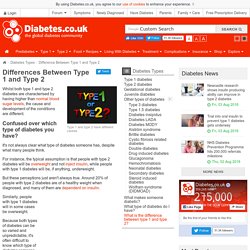
Confused over which type of diabetes you have? It's not always clear what type of diabetes someone has, despite what many people think. For instance, the typical assumption is that people with type 2 diabetes will be overweight and not inject insulin, while people with type 1 diabetes will be, if anything, underweight. But these perceptions just aren't always true. Types of Diabetes - Diabetes Queensland. Diabetes Mellitus. This answer is brought to you by many of the Australian nutrition professionals who regularly contribute to the Nutritionists Network ('Nut-Net'), a nutrition email discussion group.
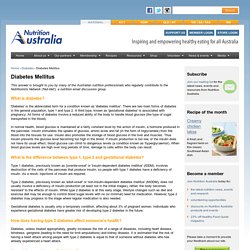
What is diabetes? Diabetes is a serious complex condition which can affect the entire body.
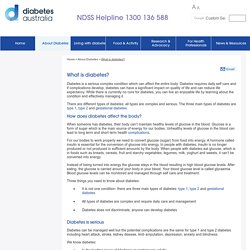
Diabetes requires daily self care and if complications develop, diabetes can have a significant impact on quality of life and can reduce life expectancy. While there is currently no cure for diabetes, you can live an enjoyable life by learning about the condition and effectively managing it. Diabetes Victoria. What is the difference between type 1, type 2 and gestational diabetes? Diabetes: Know Your Type Diabetes SA has developed information resource called 'Diabetes: Know Your Type'.

Type 1 diabetes Type 1 diabetes is an autoimmune disease. This means that the body's own immune system has attacked the insulin producing cells of the pancreas. The pancreas can no longer produce insulin when this occurs. How is it managed? Administering insulin by injections or a pump will help to manage blood glucose levels. Diabetes information - St Vincent's Hospital Sydney. Have you just been diagnosed with diabetes?
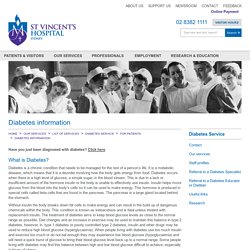
Click here. What is Diabetes? Diabetes is a chronic condition that needs to be managed for the rest of a person’s life. It is a metabolic disease, which means that it is a disorder involving how the body gets energy from food. Diabetes occurs when there is a high level of glucose, a simple sugar, in the blood stream. Without insulin the body breaks down fat cells to make energy and can result in the build up of dangerous chemicals within the body. Diabetes: the silent pandemic in Australia. Diabetes. Overview Diabetes mellitus refers to a group of diseases that affect how your body uses blood sugar (glucose). Glucose is vital to your health because it's an important source of energy for the cells that make up your muscles and tissues.
It's also your brain's main source of fuel. WIN News Canberra - Diabetes Week. National Diabetes Week. National Diabetes Week 2020 is on from July 12 - July 18.

Diabetes is relentless. Every minute of every day, a person with diabetes faces decisions, thoughts, worries and fears about their diabetes and the future impact the condition may have on their health. The risk factors of type 2 diabetes. Risk Factors - Diabetes Queensland. We do not know the exact cause of type 1 diabetes.
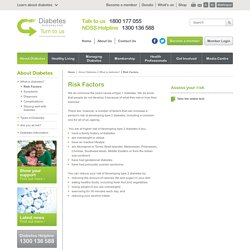
We do know that people do not develop it because of what they eat or how they exercise. There are, however, a number of factors that can increase a person's risk of developing type 2 diabetes, including a common one for all of us: ageing. You are at higher risk of developing type 2 diabetes if you: have a family history of diabetes are overweight or obese have an inactive lifestyle are Aboriginal or Torres Strait Islander, Melanesian, Polynesian, Chinese, Southeast Asian, Middle Eastern or from the Indian sub-continent have had gestational diabetes have had polycystic ovarian syndrome. Type 2 diabetes. Diabetes is a condition that occurs when the body cannot maintain healthy levels of sugar (glucose) in the blood.

Type 1 diabetes develops when the pancreas is unable to produce insulin. Type 2 diabetes develops when the body does not make enough insulin or does not use it well. Type 2 diabetes may be managed with healthy eating and physical activity. But if these lifestyle changes aren’t enough to control blood glucose levels, diabetes medications are also used. What is type 2 diabetes? The pancreas is an organ below and behind the stomach. In type 2 diabetes, the body’s cells do not respond effectively to insulin. Can cultural background influence diabetes risk? Your risk of developing diabetes doesn’t just depend on the kinds of foods you eat or how much you exercise.

According to CEO of Diabetes Australia, Greg Johnson, it also depends on your cultural heritage. “There are many populations of people, living in Australia, who are more pre-disposed to developing diabetes because of their genes,” says Johnson. “People from China, India and the subcontinent, South East Asia, Middle East, North Africa are more pre-disposed to develop type 2 diabetes than people who aren’t from these countries. According to the International Diabetes Federation (IDF), there were over 78 million people living across South East Asia with diabetes in 2015. This is expected to increase to 140 million by 2040. Research has also identified type 2 diabetes an increasing epidemic in Asia, characterised by an onset at a relatively young age and low body mass index. “So I explain to them what diabetes means and tell them what’s happening in their bodies. Sizing up the problem. Understand Your Risk for Diabetes. Healthy diet. Overview Consuming a healthy diet throughout the life-course helps to prevent malnutrition in all its forms as well as a range of noncommunicable diseases (NCDs) and conditions.
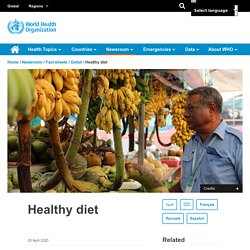
However, increased production of processed foods, rapid urbanization and changing lifestyles have led to a shift in dietary patterns. People are now consuming more foods high in energy, fats, free sugars and salt/sodium, and many people do not eat enough fruit, vegetables and other dietary fibre such as whole grains. The exact make-up of a diversified, balanced and healthy diet will vary depending on individual characteristics (e.g. age, gender, lifestyle and degree of physical activity), cultural context, locally available foods and dietary customs.
However, the basic principles of what constitutes a healthy diet remain the same. For adults A healthy diet includes the following: For infants and young children Practical advice on maintaining a healthy diet Fruit and vegetables Fats Salt, sodium and potassium Sugars. Sugar quiz: How much sugar is in our food? 10 Questions remain How much Coke can you drink before you reach six teaspoons of sugar? How many Weet-Bix can you eat before you reach six teaspoons of sugar? LIMIT:742.5g(45 biscuits) YOU SAID:16.5g(1 biscuit) SERVING SIZE:33g(2 biscuits) 16.5g(1 biscuit) Risk factors for type 2 diabetes. Diabetes - long-term effects. Reducing risk of diabetes complications Diabetes is a condition in which there is too much glucose (a type of sugar) in the blood. Over time, high blood glucose levels can damage the body's organs. Possible complications include damage to large (macrovascular) and small (microvascular) blood vessels, which can lead to heart attack, stroke, and problems with the kidneys, eyes, gums, feet and nerves.
Reducing risk of diabetes complications The good news is that the risk of most diabetes-related complications can be reduced by keeping blood pressure, blood glucose and cholesterol levels within recommended range. Regular check-ups and screening are important to pick up any problems early. Diabetic Eye Disease. On this page: What is diabetic eye disease? Diabetic eye disease is a group of eye problems that can affect people with diabetes. These conditions include diabetic retinopathy, diabetic macular edema, cataracts, and glaucoma. Over time, diabetes can cause damage to your eyes that can lead to poor vision or even blindness.
But you can take steps to prevent diabetic eye disease, or keep it from getting worse, by taking care of your diabetes. The best ways to manage your diabetes and keep your eyes healthy are to manage your blood glucose, blood pressure, and cholesterol, sometimes called the diabetes ABCs If you smoke, get help to quit smoking External link have a dilated eye exam once a year Photo courtesy of the National Eye Institute, NIH. Often, there are no warning signs of diabetic eye disease or vision loss when damage first develops.